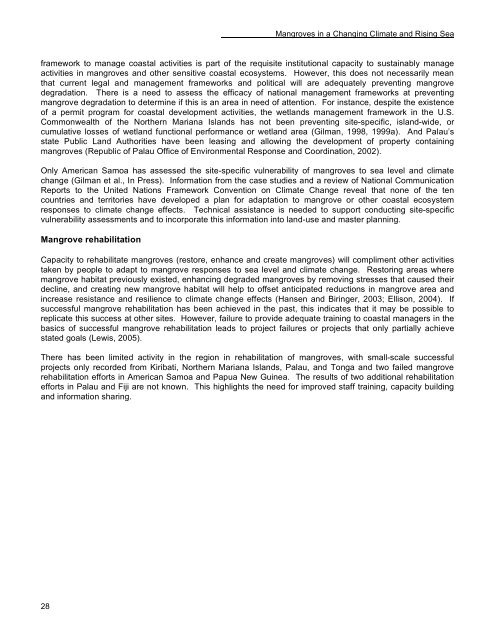Pacific Island Mangroves in a Changing Climate and Rising Sea
Pacific Island Mangroves in a Changing Climate and Rising Sea
Pacific Island Mangroves in a Changing Climate and Rising Sea
You also want an ePaper? Increase the reach of your titles
YUMPU automatically turns print PDFs into web optimized ePapers that Google loves.
28<br />
<strong>Mangroves</strong> <strong>in</strong> a Chang<strong>in</strong>g <strong>Climate</strong> <strong>and</strong> Ris<strong>in</strong>g <strong>Sea</strong><br />
framework to manage coastal activities is part of the requisite <strong>in</strong>stitutional capacity to susta<strong>in</strong>ably manage<br />
activities <strong>in</strong> mangroves <strong>and</strong> other sensitive coastal ecosystems. However, this does not necessarily mean<br />
that current legal <strong>and</strong> management frameworks <strong>and</strong> political will are adequately prevent<strong>in</strong>g mangrove<br />
degradation. There is a need to assess the efficacy of national management frameworks at prevent<strong>in</strong>g<br />
mangrove degradation to determ<strong>in</strong>e if this is an area <strong>in</strong> need of attention. For <strong>in</strong>stance, despite the existence<br />
of a permit program for coastal development activities, the wetl<strong>and</strong>s management framework <strong>in</strong> the U.S.<br />
Commonwealth of the Northern Mariana <strong>Isl<strong>and</strong></strong>s has not been prevent<strong>in</strong>g site-specific, isl<strong>and</strong>-wide, or<br />
cumulative losses of wetl<strong>and</strong> functional performance or wetl<strong>and</strong> area (Gilman, 1998, 1999a). And Palau’s<br />
state Public L<strong>and</strong> Authorities have been leas<strong>in</strong>g <strong>and</strong> allow<strong>in</strong>g the development of property conta<strong>in</strong><strong>in</strong>g<br />
mangroves (Republic of Palau Office of Environmental Response <strong>and</strong> Coord<strong>in</strong>ation, 2002).<br />
Only American Samoa has assessed the site-specific vulnerability of mangroves to sea level <strong>and</strong> climate<br />
change (Gilman et al., In Press). Information from the case studies <strong>and</strong> a review of National Communication<br />
Reports to the United Nations Framework Convention on <strong>Climate</strong> Change reveal that none of the ten<br />
countries <strong>and</strong> territories have developed a plan for adaptation to mangrove or other coastal ecosystem<br />
responses to climate change effects. Technical assistance is needed to support conduct<strong>in</strong>g site-specific<br />
vulnerability assessments <strong>and</strong> to <strong>in</strong>corporate this <strong>in</strong>formation <strong>in</strong>to l<strong>and</strong>-use <strong>and</strong> master plann<strong>in</strong>g.<br />
Mangrove rehabilitation<br />
Capacity to rehabilitate mangroves (restore, enhance <strong>and</strong> create mangroves) will compliment other activities<br />
taken by people to adapt to mangrove responses to sea level <strong>and</strong> climate change. Restor<strong>in</strong>g areas where<br />
mangrove habitat previously existed, enhanc<strong>in</strong>g degraded mangroves by remov<strong>in</strong>g stresses that caused their<br />
decl<strong>in</strong>e, <strong>and</strong> creat<strong>in</strong>g new mangrove habitat will help to offset anticipated reductions <strong>in</strong> mangrove area <strong>and</strong><br />
<strong>in</strong>crease resistance <strong>and</strong> resilience to climate change effects (Hansen <strong>and</strong> Bir<strong>in</strong>ger, 2003; Ellison, 2004). If<br />
successful mangrove rehabilitation has been achieved <strong>in</strong> the past, this <strong>in</strong>dicates that it may be possible to<br />
replicate this success at other sites. However, failure to provide adequate tra<strong>in</strong><strong>in</strong>g to coastal managers <strong>in</strong> the<br />
basics of successful mangrove rehabilitation leads to project failures or projects that only partially achieve<br />
stated goals (Lewis, 2005).<br />
There has been limited activity <strong>in</strong> the region <strong>in</strong> rehabilitation of mangroves, with small-scale successful<br />
projects only recorded from Kiribati, Northern Mariana <strong>Isl<strong>and</strong></strong>s, Palau, <strong>and</strong> Tonga <strong>and</strong> two failed mangrove<br />
rehabilitation efforts <strong>in</strong> American Samoa <strong>and</strong> Papua New Gu<strong>in</strong>ea. The results of two additional rehabilitation<br />
efforts <strong>in</strong> Palau <strong>and</strong> Fiji are not known. This highlights the need for improved staff tra<strong>in</strong><strong>in</strong>g, capacity build<strong>in</strong>g<br />
<strong>and</strong> <strong>in</strong>formation shar<strong>in</strong>g.

















